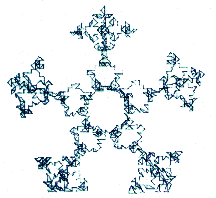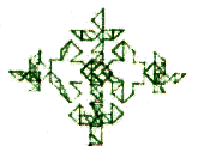

A manifold is defined as a topological space with fundamental characteristics common to a sphere. Each point is therefore homeomorphic to that of a sphere -- meaning that each point in use and function can be continuously deformed into those points which make up a sphere.
The arrangement of human thought and information around an architectonic metaphor has had a long history. Some what recently however, Roger Penrose, in The Emperor's New Mind: Concerning Computers, Minds, and The Laws of Physics (New York: Penguin Books, 1989), suggested that the information contained in the human mind might be stored within an N-dimensional manifold in which each dimension is shifted slightly out of phase from one another. Simple patterns of information and thought are reiterated into a great variety and complexity that are self-similar as one shifts focus, point of view, and dimension. It is an arrangement most often found in the natural world, and has been mathematically abstracted as the popular subset of chaos theory known as fractal geometry.
Whatever the case may be, it is Penrose's contention that the human brain has a unique biological composition, and that human thought could not exist without this particular physical structure existing. Attempts at mimicking human thought, such as in artificial intelligence, fail because only the logic and outcome of the thought process have been examined for the model. Presently, the mental/physical arrangement from which thought arises defies any contemporary reductive analysis procedure. Also therefore, any attempt at separating thought from its organic basis will ultimately collapse and betray its origins in an individually unique structure.
The acquisition of language (among the human race's first technologies) through the phonemic control of vocal sound is the first human act of abstraction -- the wide variety of sounds which the human voice can produce have been reduced to a subset of between 40 to 60 meaningful phonemes for each particular language. Subsequently each technological development in media, such as writing, printing, radio, tape recorders, video, on up to the Internet, is a refinement upon a previous level of abstraction. Since all human endeavor appears to be based upon the acquisition of language, each technological development in communication has led to another culture such as oral tradition, manuscript, print, video, digital, etc., each erasing the culture of the past as well as claiming to extend the boundaries of human cognition and experience.
As every new media form strikes out onto a new frontier of exploration and colonization, it leaves behind the luggage from its past like discarded belongings along a wagon trail. It believes in its own virgin history without genealogical origins. The personal voice was thrown out long ago, like rotting salt pork or Grandma's old cane rocker, however it is not quite forgotten. Beneath the thin candy shell (which "melts in the mouth, not in the hand!") of the next step in media development as the World Wide Web, one finds the personal voice ensnared and its uniqueness abstracted to the point where we believe we cannot hear it anymore. But its amputated sound haunts our imaginations, directs our movements within this new media, and turns around occasionally to bite us on our nether regions when we attempt to ignore or completely forget it.
